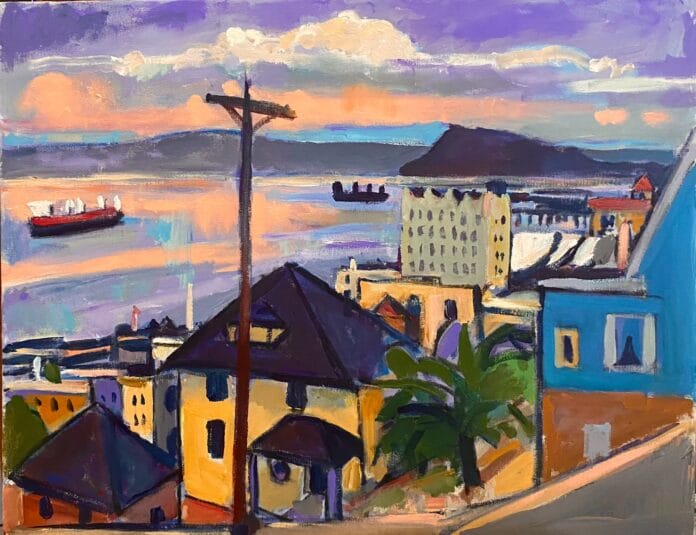Mark Andres is a painter and filmmaker living in Portland, Oregon, whose career has spanned more than four decades. His landscapes, figurative work, still lifes, and narrative paintings have been exhibited in galleries for over 40 years, establishing him as a distinctive voice in contemporary art. His animated silent films have earned international recognition, winning Best Animated Film Awards in Los Angeles, New York, Chicago, and Mexico City.
In addition to his work on canvas and screen, Andres is also a writer and recipient of a Massachusetts Foundation Fellowship and a Literary Arts Grant. His paintings are included in major public collections in the Pacific Northwest, such as the Portland Art Museum, the Hallie Ford Museum of Art, and the Marylhurst Museum of Art.
Through his work across painting, film, and writing, Andres consistently pursues a vision that explores the rhythms of life and the deep connections between imagination and the natural world.
Painting as a Meeting Place
Andres views painting as an intersection where nature and imagination converge. To him, paintings occur at the place where looking meets sensibility. This perspective defines his entire approach: painting is not merely an act of depicting reality but of uniting external observation with internal perception.
He sees painting as a delicate balance of outward and inward looking. The external world asserts its hidden rhythms at every moment, but naming them, he believes, will not help. For Andres, painting is preverbal. Where naming pulls the world apart, painting has the capacity to put it back together.
This philosophy underlines his refusal to reduce his subjects to labels or categories. Instead, he allows painting to hold complexity, mystery, and synthesis, creating works that engage viewers in a form of silent recognition beyond words.
Witnessing Hidden Rhythms
Central to Andres’ practice is his belief in hidden rhythms, those patterns of birth, death, longing, and renewal that form the foundation of human existence. These rhythms, he suggests, are mysteriously embedded in the natural and built environment: in rivers, in factories, in towns, and in the quiet spaces that surround us.
No photograph, in his view, can convey the vitality of these rhythms. Painting, however, can. By synthesizing what is seen with what is felt, painting reveals connections that photography cannot capture. It becomes a medium through which the universal cycles of life are not just observed but experienced.
This sensitivity elevates his subject matter. A seemingly ordinary landscape or industrial view is not merely a record of place but a meditation on human origins and eternal return. His paintings bear witness not only to external scenes but also to the emotional and spiritual resonances they carry within them.
Expanding the Vision: Film and Writing
While painting remains at the center of his practice, Andres has expanded his exploration of rhythm, silence, and perception through film and writing. His animated silent films embody the same principles as his paintings. Devoid of dialogue or sound, they invite audiences into a contemplative space where rhythm, gesture, and imagery carry meaning.
These films, which have been recognized with awards in international festivals, underscore the universality of his artistic vision. Like his paintings, they transcend language, geography, and culture, creating experiences that connect directly with viewers on an emotional and intuitive level.
His achievements as a writer further demonstrate his range. With grants and fellowships recognizing his literary contributions, Andres continues to shape ideas through words, though always with the awareness that language has limits. Whether writing, painting, or making films, his work circles back to the same essence: bearing witness to the world’s rhythms and revealing the unity within its complexity.
Legacy and Continuing Relevance
Mark Andres’ body of work illustrates a rare blend of tradition and experimentation. As a painter, he engages with long-standing genres such as landscape, figure, and still life, while imbuing them with philosophical depth and spiritual resonance. As a filmmaker, he pushes the boundaries of silent cinema, proving that the absence of words can be a powerful tool for meaning.
His insistence that painting is preverbal and unifying has particular relevance in today’s world. At a time when language often fragments and divides, Andres reminds us that art can restore wholeness. His paintings and films suggest that beneath appearances lie rhythms that connect us all, patterns that transcend culture, era, or place.
This vision positions him not only as a chronicler of the Northwest, where his work is prominently collected, but as an artist whose insights reach far beyond regional boundaries. His art is a meditation on the human condition, expressed through rivers, towns, and still lifes, yet always pointing toward universal truths.
Conclusion
Mark Andres has spent his career exploring the dynamic meeting of imagination and nature, of perception and reality. Through painting, he reassembles the fragmented world, giving form to hidden rhythms that photography and words cannot convey. Through film and writing, he expands this exploration, offering audiences diverse entry points into his vision.
His legacy is one of devotion to seeing, feeling, and bearing witness. In every medium he touches, Andres honors the complexity of life, the cycles of existence, and the silent rhythms that connect us all. His work remains a testament to the enduring power of art to bring the world back together.


